Additional notes on the differences between Traditional (Linnaean system) classification or Cladistics (Phylogenetics).
Every course that considers diversity among organisms must find a way to organize this information to make it understandable to the students in the course. That means that in such a course, students must review or learn and deal with current classification practices. Often introductory information about classification uses more familiar organisms to introduce important concepts, so vertebrate example as opposed to invertebrate examples. I will also use vertebrate examples from time to time just to illustrate important differences between invertebrates and vertebrates. For example, next week, we will explore some of the differences between arthropod and vertebrate nervous systems.
An introduction (review) of classification.
Today, taxonomists construct phylogenetic trees to depict relationships among groups of organisms. It has always been a way or organize the millions of species found on the planet, in some sensible way, by grouping them according to similarities. We group objects in all sorts of storage areas for the same reason. You want to buy some cheese for lunch. Do you wander up and down the aisles of a large supermarket without direction until you find the type of cheese you want? No! you go to the dairy or deli section. These organizations can be used for more than simply increasing our ability to find "like items." We may expand our knowledge about cheeses by trying samples or watching some demo on how to use a particular type of cheese.
Somewhere in high school or your other courses in college you have been introduced to the basic vocabulary of classification. To review please visit this website and answer the appropriate questions on the study guide.
https://evolution.berkeley.edu/evolibrary/article/evo_03
to
https://evolution.berkeley.edu/evolibrary/article/0_0_0/evo_07
(We will be visiting this website developed to treat evolutionary topics from a level directed at advanced high-school to graduate school. I appreciate that it starts at an introductory level but advances quickly and treats topics that are anything but introductory. )
Various systems have been used, most have been abandoned for one reason or another. Please read the description of some of the systems that have been used in the past. Our current system officially is dubbed phylogenetics but more often referred to as cladistics. Mainly you should focus on being able to compare phylogenetics and an older system known as classical, traditional, or evolutionary systematics.
Some history on classification systems.
Example: phenetics
At one time from about the 1970's to about 1990's, taxonomists or those individuals interested in classification science decided to let the computers do all the work for them. Species were simply compared for hundreds of traits, if not more, with the assumption that if closely related, they would share more descent traits or those inherited from a common ancestor than those shaped by lifestyle. For example, living in ocean has shaped the appendages of seals into fin or fish like flippers, although seals are more related to other mammals than any sort of fish. This school or approach to classification was know as phenetics. Soon however it became apparent that there were inherent biases even in regard to this school.
Examine the following diagram. It depicts the scatter graph of two characteristics for 5 species. Note that it is apparent that species 1 and 2 cluster together (A) with regard to the traits, and species 4 and 5 (Cluster B) also group together. Yet two different quantitative approaches differ in regard to where species 3 is placed on a relationship tree using these data. Nearest neighbor analysis results in a tree that places species 3 more closely related to species one and two, while average neighbor analysis results in a tree that places species 3 more closely related to species 4 and 5.
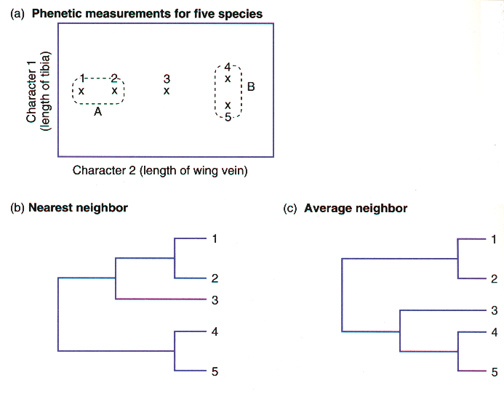
Other problems involved picking a tree if the analysis resulted in several likely trees. In phenetics, all characters and analyses are equal. There was also a growing concern that phenetics did not respect homologies or those characteristics inherited from a common ancestor. After all, the primary goal was to reveal the phylogeny or evolutionary history of a group being studied.
Today, the modern way to classify organisms that has gained wide acceptance is known as the phylogenetics or cladistics school or approach. It replaces (but sometimes is used in conjunction) with what is often know as the evolutionary, classic or traditional method of classification. This latter method has been in place since Linneaus group organisms on similarities. It was the one turned to the most throughout the years as taxonomists tried new methods, such as phenetics, simply to abandon them. However, now it has been replaced with the phylogenetics approach.
Let's review the assumptions of the latter or older school and then examine "cladistics" in more detail.
Evolutionary systematics or simply the classic or traditional method because it is the oldest of the two used.
It attempts to show relationships that depict the lineage or history of descent of a particular group.
It uses as its basic unit or taxa the species. Each species has a name consisting of two words. Note the first word in the examples below are capitalized and the entire name is italicized or underlined.
Canis lupus
Panthera pardus
Eublepharis macularius
Groups form a collective hierarchy (nested grouping) from species to domain. Each higher or larger unit contains one or more groups from lower level.
Kingdom: Animalia
Phylum: Chordata
Class: Mammalia
Order: Carnivora
Family: Canidae
Subfamily: Caninae
Tribe: Canini
Genus: Canis
Species: C. lupus
Since Darwin, taxa distinctions are made following the basic tenet "Taxonomy should reflect phylogeny (evolutionary history=relatedness)." Two species in one taxa at any level must be more closely related (share more in common from descent) to each other than to species in other taxa at the same level.
So, recognizing and using characters that are homologous is important.
______________________________________________________________________________________________________
Homologous: Structurally similar due to common ancestry. Having the same evolutionary origin but not necessarily the same function. Visit this page for a basic discussion of homology versus analogy. https://evolution.berkeley.edu/evolibrary/article/0_0_0/evo_09
________________________________________________________________________________________________________________
But remember equal taxa can do this even if some are older or some are bigger and contain more species.
There are more differences between some taxa of equal standing than others.
Examples: Vertebrate classes recognized in evolutionary systematics, such as Amphibia, Reptilia, Aves and Mammalia.
1. Aves (birds) and Mammalia are younger classes than Amphibia and Reptilia. Both birds and mammals descended from closely related ancestors yet there are more differences between mammals and some modern reptiles than birds and some modern reptiles
2. The platypus could be classified as a mammal or reptile. It has hair and mammary glands that are simple slits. It lays eggs and the skeleton, if only known from fossil limbs and vertebrae, could appear reptilian.
3. Should Chordata be a phylum, given the small number of species in it? Arthropoda contains about 1.25 million described species, Chordata contains only 43,000 species.
So one does not know by simply looking at a tree whether branching arrangements are based mainly on certain characters or the ancestor shared.
It is this lack of testing, limits, and so in some sense predictive and hypothesis testing value of the trees constructed, via evolutionary systematics, that has led to the greater acceptance today of the second method or cladistics/phylogenetics.
Phylogenetics or cladistics
This is now the accepted way to classify organisms. It is slowly replacing the evolutionary approach in textbooks. Cladistics is a type of systematics developed by Willi Hennig, who attempted to develop a more scientific method of classifying organisms. This scheme only uses one type of homology (derived) for construction of "clades". Molecular phylogenetic analysis was being at the same time practiced by biologists who were using DNA and/or RNA sequences to group animals but with the same objectives postulated by Hennig. The two approaches have merged for the most part in what is now know formally as phylogenetics or informally as cladistics. Most cladists in fact use molecular data to construct cladograms.
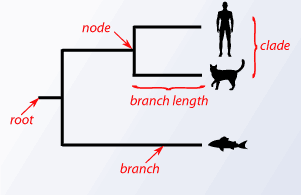
It uses strict monophyly as the only criterion for grouping related species. In cladistic taxonomy, evolution is seen as a process of progressive bifurcations of lineages. Every species, therefore, has a sister species whether recognizable or not, and this pair is derived from an ancestral species. Two taxa are more closely related to each other (sister groups) if they share a more recent common ancestor relative to a third.
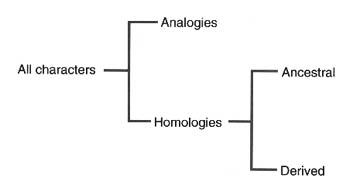 -
-
Derived homologies define a clade and are restricted to that clade.
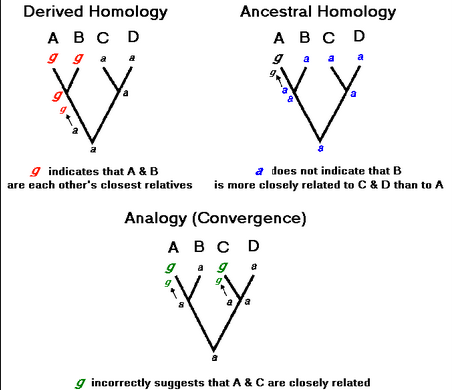
Cladistics depends on identifying shared derived characters. or synapomorphies. Cladists then distinguish between different types of homologies.
A derived homology is unique to a particular group of species (and their ancestor), while a shared ancestral homology is found in the ancestor of a group of species but only in some of its descendants.
One way of looking at synapomorphies is that they define nodes, groups of sister species and their closest relative. The very formal and rigorous way synapomorphies and nodes are used, make the trees drawn, true lineage trees.
In summary, cladistics the emphasis is on producing a monophyletic grouping. It is a shared derived character that defines a clade. This method is the one currently accepted by most taxonomists.
In the diagram below the clades or groups are indicated at top for example, Vertebrates and Tetrapods. The shared derived characters for a clade are indicated below the clade, so the tetrapod "clade" all have 4 limbs, but no other clade has this characteristic and it is a "new" or derived trait (not an ancestral trait or trait found in an remote ancestor to this clade). Each branch point is known as a node.
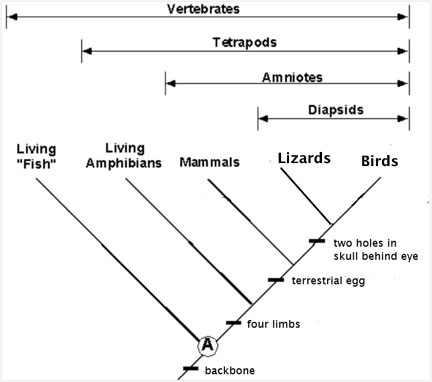
Some would argue that given the vagueness of the fossil record it is difficult to determine whether characters are homologous or analogous, yet alone derived or ancestral. Out groups are used. Out groups are clades outside the group under study that must have diverged before the group evolved. The rule of thumb is to use fossils to root your trees whenever possible, but out groups can help the placement of branches with unknown or contested ancestry, or root trees based on molecular data that can then be compared to trees based on morphology.
Many textbooks superimpose the taxa names of the evolutionary school (also known as the classic or traditional school) for clades, although these do not formally exist in phylogenetics. This right now just adds to the confusion, although in time it may help define what are know as crown clades or the larger groupings in the evolutionary school such as kingdoms, and phyla. From now on I will be using the term clades, although often I will indicate the old school taxa name (phyla, or class for example) in parentheses.


 -
-
